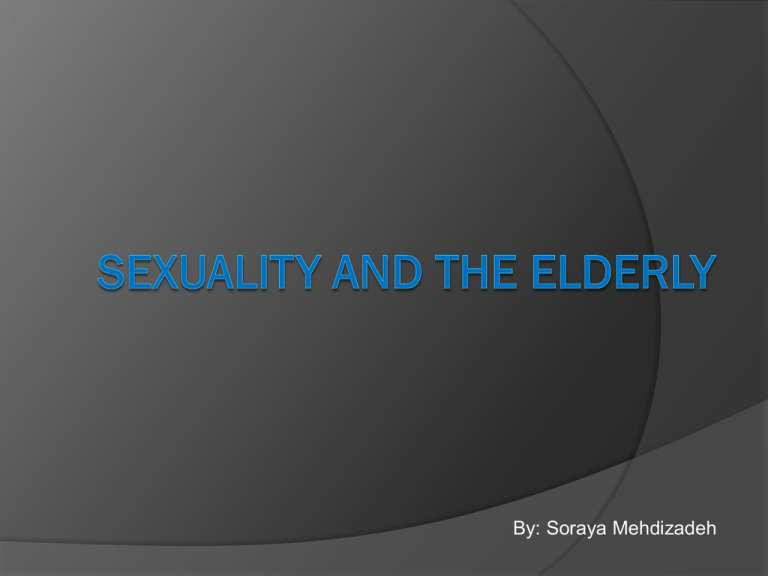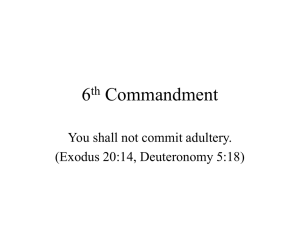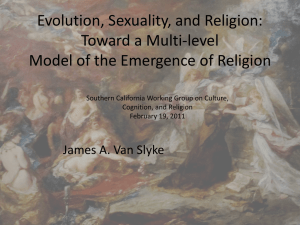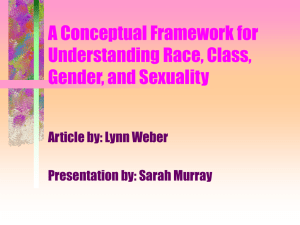
By: Soraya Mehdizadeh
What is Sexuality?
Sexuality:
“Encompasses sex, gender identities
and roles, sexual orientation, eroticism,
pleasure, intimacy and reproduction.
Sexuality is experienced and expressed
in thoughts, fantasies, desires, beliefs,
attitudes, values, behaviours, practices,
roles and relationships”
(WHO, 2009)
What is Sexuality?-Cont’d
Intrinsic
vs.
Socially Constructed?
Western Historical View of
Sexuality in Late Life
Middle Ages (Covey, 1989)
○ Older men who were able to maintain active
sex lives were believed to have exceptional
qualities, were given high social status, and it
was thought to increase their life spans
○ Older women who were sexually active were
thought to use witchcraft to trick men into
going into bed with them
Modern Western Views of
Sexuality in Late Life
Assumption that older people are asexual or impotent
Sexuality is taboo, unimportant, or irrelevant to older
people
Aging is characterized by a continual physical and
cognitive decline
The media associates sexuality with attractive youth,
this shapes our beliefs about older people
Health researchers tend to overlook sexual views of
older people
Aging heterosexual men have a greater choice of
partners and expression of sexuality than older women
(As cited in Bauer, McAuliffe, & Nay, 2007)
Sexuality and Aging: A
study of 106 cultures
(Winn & Newton, 1982)
Other Findings Related to
Sexuality, Culture, & the Elderly
Kalaheri Desert, Africa
○ Elderly are valued and respected.
○ Females gain more social status with age
○ Female elderly status allows them to choose
partners among the younger men
Abkhasians in the Caucasus
○ Men and women are sexual into old age
(Encyclopedia for women and gender, 2002)
Traditional Chinese Taoists
○ Sexuality is considered healthy for the elderly
Inis Baeg of Ireland
○ Sex negative society
○ Postmenopausal women are seen as
nonsexual and susceptible to mental illness
Uttar Pradesh in Northern India
○ Male-female sexual relations are suppose to
end after the birth of their first son
(Encyclopedia for women and gender, 2002)
Psychological Perspective: Why is
sexuality important for the elderly?
Quality of life
Maintenance of healthy interpersonal
relationships
Self-concept
Integrity
Self-worth
Mental health
(Hajjar & Kamel, 2003; Zanni et al., 2003)
Theory of Development & Aging
Erikson’s 8 Stages of Psychosocial
Development
○ Unfolds according to both an innate scheme and
one's up-bringing in a family that expresses the
values of a culture
○ Each stage builds on the preceding stages, and
paves the way for subsequent stages
○ Each stage is characterized by a psychosocial
crisis, which is based on physiological
development, but also on demands put on the
individual by parents and/or society
○ Ideally, the crisis in each stage should be resolved
by the ego in that stage, in order for development
to proceed correctly
Biological Perspective: Sexuality
in Late Life
Sexual Response cycle
○ drive, arousal, orgasm, resolution
Drive remains the same in both men and
women, although frequency may decrease
Arousal is most affected by aging
Orgasm is least affected (although may
require more time)
Refractory phase especially affected in
older men
(As cited in Sharpe, 2004)
Biological Perspective: Women
Shortening and narrowing of vagina
Less acidic vaginal secretions
Decreased estrogen levels (decreased
clitoris size, graying of pubic hair)
(As cited in Sharpe, 2004)
Biological Perspective: Men
Decreased production of testosterone
Testicles decrease in size and firmness
Sperm production is reduced
Prostate increases in size
Less pre-ejaculatory fluid
Less durable/ firm erections
(As cited in Sharpe, 2004)
Health Related Barriers to
Sexuality in Late Life
Parkinson’s Disease
Dementia
Rheumatoid Arthritis
Surgical Interventions
Alcohol Abuse
Incontinence
Diabetes/ hypertension/ stroke/ cardiac
disease/ depression
(As cited in Bauer, McAuliffe, & Nay, 2007)
STDs & HIV/AIDS in Late Life
Older adults account for 1.3% of all STDs
Most common STD in older women are genital
herpes; in men, the most common is
nongonoccoccal urethritis
Risks
○ Lack of knowledge and experience with condom use,
○
○
○
○
decreased fears of pregnancy (Hillman, 2000)
Postmenopausal women are more susceptible to vaginal
tears, allowing viruses greater access to the
bloodstream
Cultural norms regarding sex
Lack of knowledge amongst the health care community
No national health campaigns exist regarding STD
transmission, testing, or treatment for older adults
(As cited in Hillman, 2008)
Social Barriers to Sexuality in Late
Life: Healthcare Professionals
Ageism
Reluctant to discuss concerns with medical
practitioners due to embarrassment, beliefs
that their problems are simply due to normal
aging
Particularly difficult for men
Doctors and physicians tend to generally be
uncomfortable about raising the issue
(As cited in Bauer, McAuliffe, & Nay, 2007)
Social Barriers to Sexuality in Late
Life: Institutions
Healthcare
institutions and nursing
homes are generally not supportive of
sexualized behaviour (Bauer, McAuliffe, & Nay, 2007)
Little consultation with residents about
sexual needs; often it is viewed as an
activity that should be curtailed (Hajjar & Kamael,
2003)
Psychological
barriers such as threats
and punishment have been used to
control sexualized behaviour (Roach, 2004)
Social Barriers to Sexuality in Late
Life: Partners
For women in particular, the availability
of partners is an issue (Benbow & Jagus, 2002).
Loss of a partner/ bereavement
○ i.e. Widower’s syndrome
(As cited in Sharpe, 2004)
CONCLUSIONS
Thank you for listening.
Questions or comments?









